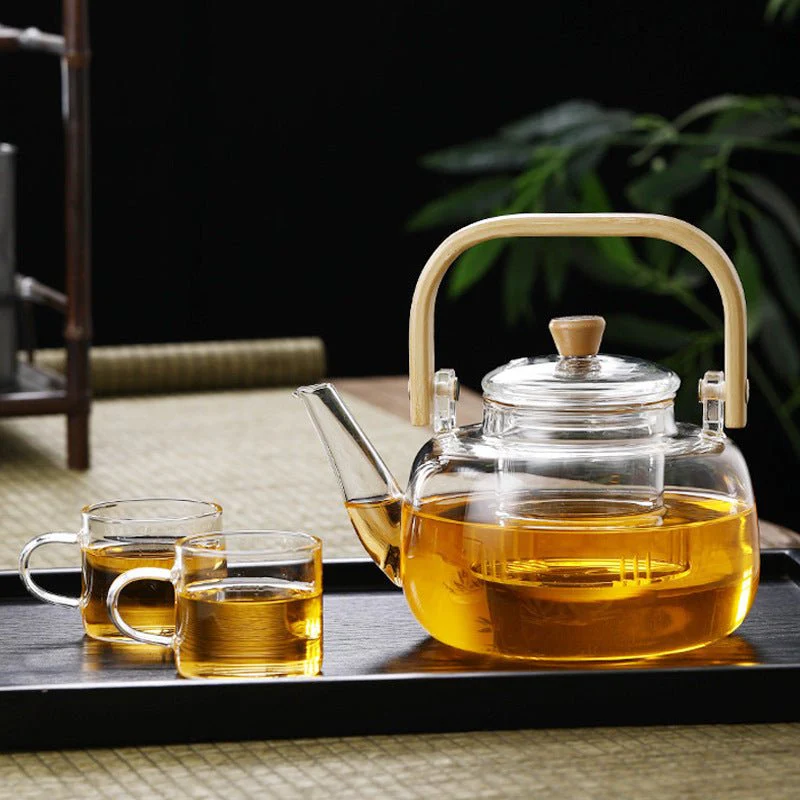Top Ten Famous Teas in China
2025-08-06
China is a major tea-producing country, and this is reflected in the wide variety of teas available. Currently, there are more than 1,000 well-known types of tea throughout the country. Many of these teas are very famous. If one were to rank them, different people would come up with different lists. Below, we present one such ranking:
1. Hangzhou Longjing
Originally a place and spring name, Longjing is now primarily used as a tea name. Longjing tea is produced in Longjing Village in the Zhejiang Province of China. Historically, it was divided into four categories: 'Lion, Dragon, Cloud and Tiger', with tea from the old well on Lion Peak being considered the finest. Longjing is a pan-fired green tea that is renowned worldwide for its 'four excellences': green colour, fragrant aroma, mellow taste and beautiful shape. Good tea requires good water to brew. 'Longjing tea and Huipao water' are collectively known as the 'two treasures of Hangzhou'. Huipao water contains a higher concentration of organic nitrogen compounds and fewer soluble minerals, which enhance the aroma and flavour of Longjing tea more effectively. A glass cup is recommended for brewing Longjing tea, as its transparency allows the tea leaves to gradually unfurl, with each bud and stem floating up and down in the clear, green tea liquor. Carefully observing this process is a real treat for the senses.
Good tea deserves a good teapot. Using a high-quality teapot to brew your tea will enhance your sense of well-being and allow you to enjoy a fragrant, premium cup of tea. We recommend this simple, convenient teapot for brewing tea.
https://www.rora.top/products/auto-brew-glass-tea-set_58321a46
Good tea deserves a good teapot. Using a high-quality teapot to brew your tea will enhance your sense of well-being and allow you to enjoy a fragrant, premium cup of tea. We recommend this simple, convenient teapot for brewing tea.
https://www.rora.top/products/auto-brew-glass-tea-set_58321a46
2. Suzhou Biluochun
Biluochun tea is produced on Dongting Mountain, on the shores of Taihu Lake in Wuxi County, Jiangsu Province. Biluochun tea is made from the tender buds of tea plants picked in spring. High-quality Biluochun requires 60,000–70,000 buds to produce 0.5 kg of dried tea, which highlights their tenderness. After processing, the dried tea leaves are tightly rolled with visible white downy hairs and a silver-green colour. Their curled shape resembles a snail, hence the name 'Biluochun'. When brewed, the tea produces a cloud-like foam in the cup with a refreshing aroma, making it renowned in China and a popular premium gift.
3. Huangshan Mao Feng
Produced in Huangshan in the Anhui Province of China, it is primarily distributed around Yunju Temple, Songgu An, Diaoqiao Yan, Ciguang Pavilion and Ban Si on Taohua Peak. This area has high mountains, dense forests, limited sunlight and abundant mist, providing ideal natural conditions. The tea plants are nourished by the mist and are protected from extreme temperatures, resulting in a superior quality tea. The production of Huangshan Mao Feng is extremely meticulous. The finished tea has a slender, slightly curved shape that resembles a sparrow's tongue. It has a fragrance that is reminiscent of white orchids, and a smooth, lingering sweetness. Huangshan is home to numerous other famous teas, including "Tunlu" from Xuning, "Hou Kui" from Taiping and "Laozhu Dafang" from She County. Each tea has its own unique characteristics and is widely praised.
4. Lushan Yunwu
Produced in Lushan, Jiangxi Province. Renowned as 'the most beautiful mountain under heaven', Lushan is located north of the Yangtze River and south of Poyang Lake. Its mild climate and picturesque landscapes make it highly suitable for tea cultivation. Lushan Yunwu tea features plump buds with prominent downy hairs, elegant leaves, a rich aroma, a sweet taste and a clear infusion, making it a premium green tea.
5. Lu'an Guapian
This tea is produced in the Dabie Mountain tea region of western Anhui Province, and the highest quality comes from Lu'an, Jinzao and Huoshan counties. Harvested in spring, the finished tea takes the shape of a melon seed, hence its name. It is vibrant green in colour, has a fresh, high-pitched aroma and a sweet, refreshing taste. It can be infused multiple times. As well as quenching thirst and refreshing the palate, this tea has strong digestive and medicinal properties. During the Ming dynasty, Wen Long wrote in his 'Tea Notes' that Lu'an tea is most effective when used as a medicine; thus, it is regarded as a precious treasure.
6. Enshi Yulu
Produced in Enshi, Hubei Province. Hubei has a long history of tea production and gained fame as early as the Tang dynasty. It remains one of China's major tea-producing provinces today. Enshi Yulu is one of the few remaining steamed green teas in China. Its production process and tools date back to ancient times and closely resemble those described in Lu Yu's The Classic of Tea. Enshi Yulu has strict requirements for picking and processing. The buds and leaves must be tender, uniform and consistent in size. The finished tea has tight, slender strands and a fresh green colour. It is straight and uniform, resembling pine needles. The tea soup is clear and bright with a fresh aroma and a sweet, mellow taste, and the leaf base is green like jade. The 'three greens' (tea green, soup green, and leaf base green) are its distinctive features. Since the Tang dynasty, Japan has imported tea seeds and tea-making methods from China, and to this day it primarily uses steaming to produce green tea. The production method of Japanese Gyokuro is similar to that of Enshi Yulu, though each has its own unique characteristics.
7. Bai Hao Yin Zhen
This type of white tea is produced in Jianyang, Shuiji and Songzheng in northern Fujian, as well as in Fuding in eastern Fujian. It is covered in white, downy hairs that are as silver as snow and as slender as needles, hence its name. When brewed, the tea liquor is yellow, bright and clear, and the cup is filled with floating 'tea milk', with the silver needles standing upright and intertwined to create a beautiful sight. The tea has a fragrant and refreshing taste. As the tea leaves are not rolled during processing, it is difficult to extract the tea juice, so the brewing time should be slightly extended. White tea has a mild and cooling effect, and is used to aid digestion, refresh the mind, dispel dampness and reduce fever. It is often used as a medicinal tea. In Hong Kong and Macau, retail stores often blend a small amount of white tea with other varieties to enhance their quality and commercial value.
8. Wuyi Rock Tea
Produced in Wuyi Mountain, Chong'an County, Fujian Province. It is a semi-fermented tea, produced in a manner intermediate between green and black teas. The main varieties are “Da Hongpao”, “Bai Jiguān”, “Shuixian”, “Wulong” and “Rou Gui”. Wuyi Rock Tea has a unique quality: although it is not scented with flowers, its tea broth has a rich floral aroma. When drunk, it is sweet and fragrant with an endless aftertaste. After being introduced to Europe in the 18th century, it became very popular with the local population and was once hailed as a "cure-all medicine".
9. Anxi Tieguanyin
Produced in Anxi, Fujian Province. The production process is extremely complex, resulting in tightly rolled tea leaves that are dark green in colour with a sandy texture. High-quality Tieguanyin tea forms a layer of white frost during production as the caffeine evaporates with the moisture. When brewed, it releases a natural orchid fragrance and has a pure, rich flavour. When enjoyed with delicate gongfu teaware, the aroma is inhaled first, followed by the taste, which fills the mouth with fragrance and leaves an endless aftertaste. In recent years, Tieguanyin has become even more popular in Japan and Southeast Asia after the health and beauty benefits of oolong tea were discovered.
10. Pu'er Tea
Produced in regions such as Xishuangbanna in Yunnan Province, it is named after the city of Pu'er, where it has been traded since ancient times. The term 'Pu'er tea' refers to various types of compressed tea from Yunnan Province, made by steaming and pressing green or black tea. Examples include tuocha, cake tea, square tea and compressed tea. The superior quality of Pu'er tea is reflected not only in its aroma, smoothness and rich flavour, but also in the fact that it is primarily consumed by the Tibetan ethnic group. Its superior quality is evident not only in its aroma and flavour, but also in its valuable medicinal properties. Consequently, overseas Chinese and compatriots in Hong Kong and Macao often regard it as a health tonic.
RORA-Your Trusted Partner in glass teapot
WhatsApp: 86181 1810 7551
Email: info@rora.top
WhatsApp: 86181 1810 7551
Email: info@rora.top




